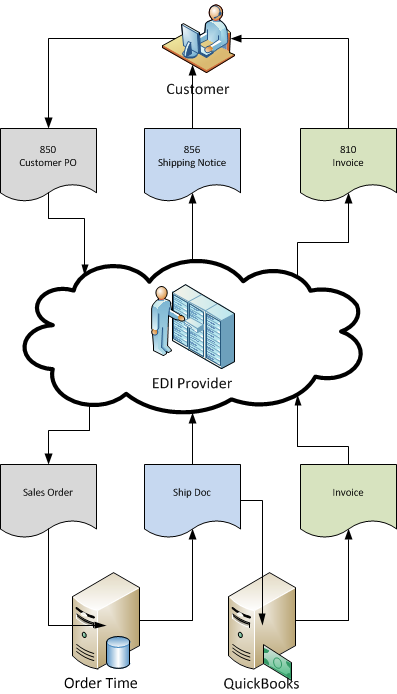Order Time EDI Integration
EDI, which stands for Electronic data interchange, is a standard method for two (or more) separate businesses using different inventory systems to exchange data. The typical data that is exchanged are purchase orders, invoices and shipping notices. Each type of document has its own number. For example a purchase order is an 850. The other business you exchange data with is called a 'trading partner' which for most small businesses is either a customer like Target or a public warehouse that does your shipping and fulfillment.
By moving from a paper-based exchange of business documents to one that is electronic, businesses enjoy major benefits such as reduced cost, increased processing speed, reduced errors and improved relationships with business partners.
Onboarding with Order time specialists during initial set up is recommended. Pricing is set at $750 for additional trading partners.
What does an EDI service provider do?
EDI is complex to setup and maintain. Luckily there are companies that specialize in helping small businesses get up and running with EDI. There are two primary things that EDI service providers do:
- Mapping: Your trading partners have a different system than you have. Moreover they refer to your products using a different number than you do. Put simply, your system and your trading partner's system speak different languages. An EDI service provider will create a 'Mapping' which is used to translate between your systems' 'language' and that of your trading partners.
- Transmission: An EDI provider operates a sophisticated network in which they receive and send data between you and your trading partners.
EDI Documents and Order Time
The following are a list of common EDI documents used to send/receive data and how they relate to the Order Time document you know and love!
810 Invoice
The 810 document is exported from an Order Time Ship Doc and is often sent to the customer alongside an 856 document. It represents an invoice for the customer to enter into their accounts payable. Typically the Invoicing is handled within QuickBooks as opposed to it being part of the EDI integration.
846 Inventory Inquiry/Advice
The 846 document sends Inventory and Item pricing information from Order Time to your trading partners. No changes are made on the Order Time side. The EDI 846 keeps retailers and suppliers up to date on inventory levels and is required for dropship or direct-to-consumer types of fulfillment models. In most cases, it is used by retailers who are asking their suppliers about current and future inventory available for their stores and warehouses.
850 Purchase Order
The 850 document is imported into Order Time to generate a Sales Order which reflects what is being ordered by the customer on the Purchase Order.
855 Purchase Order Acknowledgement
The 855 acknowledgement is exported from Order Time in response to an 850 Purchase Order document being successfully imported as a Sales Order document in Order Time. It is sent to confirm what data from the 850 was imported successfully.
856 Ship Notice/Manifest
The 856 document, also known as an ASN (Advanced Shipping Notice), is generated from Order Time when an EDI sales order is fulfilled into a Ship Doc AND the status of the Ship Doc is Shipped. The 856 can use the Line Items or Packages. When using Packages, it may also include packaging information such as a UCC 128.
Documents sent and received to and from a 3rd party logistics provider
940 Warehouse Shipping Order
The 940 document is exported from Order Time and represents an Order Time Sales Order or Ship Doc that has been created but not yet marked as shipped. This instructs the warehouse to ship products out to a specific customer.
943 Warehouse Stock Transfer Shipment Advice
The 943 document is exported from Order Time to be sent to your warehouse and represents an Order Time Purchase Order or Receiving Document that has been created but not yet received into stock. This gives the warehouse advance notice of a shipment of products on the way from a vendor/supplier to be put into stock.
944 Warehouse Stock Transfer Receipt Advice
The 944 document is imported into Order Time to confirm receipt of products from a particular vendor/supplier. This might result in an existing Order Time receiving document being updated and marked as received or the generating of a brand new receiving document.
945 Warehouse Shipping Advice
The 945 document is imported into Order Time to confirm shipment of products to a particular customer. This might result in an existing Order Time shipping document being updated and marked as shipped or the generating of a brand new ship doc.
Typical EDI Flow
The typical EDI flow will consist of the following steps. (Refer to the image below)
- Customer PO: A customer sends you a purchase order via EDI. The document is received by the EDI provider who translates the document into a format Order Time can read. The Sync downloads the PO and will automatically enter it into Order Time as a sales order.
- Shipping Notice: (optional) Some of your customers will require an Advanced Shipping Notice (ASN). The ASN contains information on the packages (cases or pallets) included in the shipment and which items are contained in each package. Each package uses a special identifier and bar code label using the UCC-128 standard. The ASN is created when the a shipment is completed within Order Time (i.e. a ship doc is created and marked as shipped).
- Invoice: Order Time will send the Ship Doc to QuickBooks as an invoice. Our supported EDI service providers also have adapters for QuickBooks that will send the Invoice to your trading partners.
 Typical EDI Flow
Typical EDI Flow
